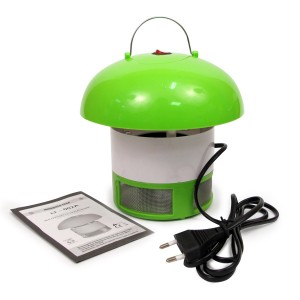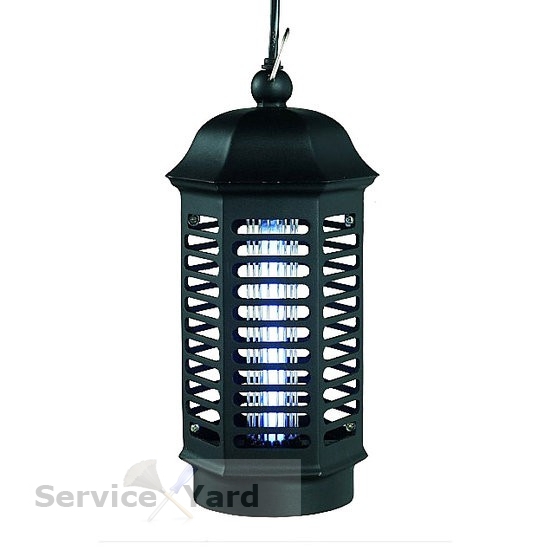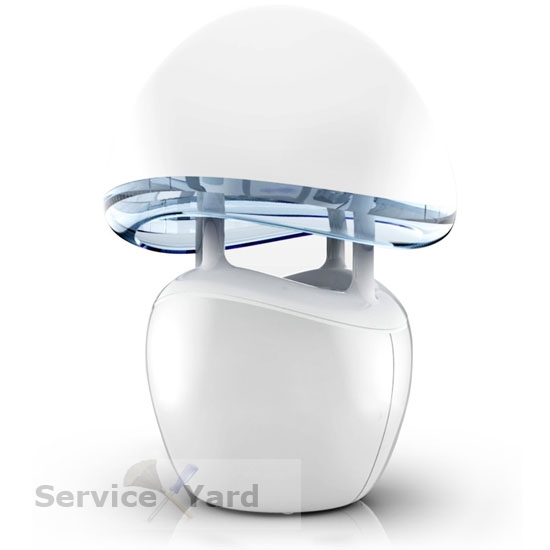Mosquito trap

In the summer, it is impossible to avoid meeting with annoying mosquitoes. Today, there are many effective tools that have chemical components in their composition, which, of course, negatively affect a person, or are completely safe, but ineffective in combating mosquitoes. If mosquitoes just got you, then a self-made mosquito trap will not only effectively save you from annoying bloodsuckers, but it is still safe not only for you, but for all households.
to contents ↑What is a mosquito trap?
Mosquito traps are devices that help you catch, not destroy or poison mosquitoes with chemicals. So, to the category of such devices can be attributed:
- Velcro.
- Light traps.
- Ultrasonic
- Thermal.
- Homemade.
 Many people wonder why mosquito traps are needed, if you can use chemicals or folk remedies, all kinds of herbs, roots, solvents. Let us tell you a secret - the fact is that only pregnant female insects bite us, since they need food in the form of human blood to breed their offspring.
Many people wonder why mosquito traps are needed, if you can use chemicals or folk remedies, all kinds of herbs, roots, solvents. Let us tell you a secret - the fact is that only pregnant female insects bite us, since they need food in the form of human blood to breed their offspring.
Important! When you apply creams, sprays, spray yourself and clothes with aerosols, the smell of a male starts to come from you. But since the female is already pregnant, she simply tries to avoid contact with the males, so for some time she does not bite you.
You cannot constantly use creams and sprays, because they contain toxic substances, so as an alternative, use at home or at the cottage various spirals and other devices that work through the network. But then again, they all expose the body to chemicals that are released into the air. Therefore, the safest way is a mosquito trap.
Consider the principle of operation of the above traps and offer several ways to make devices with your own hands.
to contents ↑DIY duct tape
Velcro is an adhesive tape coated with various enzymes that attract females. Buying them is not necessary, you can cook it yourself.
Such a mosquito trap can be prepared from improvised means:
- Prepare a cardboard sleeve on which the treated adhesive paper will be attached:
- On the sleeve, fasten the thread, which will serve as a fastener.
- Attach paper to the fabricated cartridge in any way.
- Prepare the sticky mass. All components must be melted in a water bath and gently, very thoroughly mixed. You can use several options for the ingredients, in particular:
- Pine resin - 300 g, wax - 10 g, linseed oil - 150 g, honey - 50 g.
- Rosin - 200 g, castor oil - 100 g, turpentine - 50 g, sugar syrup - 50 g.
- Glycerin - 40 g, crude honey - 100 g, rosin - 400 g, liquid paraffin - 200 g.
- Apply the finished adhesive to the paper.
- The mosquito trap is ready. Place it at the window, front door and any other place.
Electrical traps
Light traps for mosquitoes (Mosquito Trap and the like) generate light in the visible and invisible spectrum, which affects mosquitoes, attracting them. Some have nightlights for the convenience of users.
Mosquito Killer, Electro Frog devices offer a variety of flavors for mosquito bait and attract not only these bloodsuckers, but also sand flies, horseflies and house flies.
According to the principle of action, one can classify such mosquito traps:
- CO2-based systems use carbon dioxide as an additional component, for example, to ultrasound. Some device models have settings that allow the owner to program the rate of removal, and even the removal of CO2 from the cylinders. Some traps burn propane to emit CO2, while others use pure CO2.
- Temperature systems use a form of heat transfer to attract mosquitoes. The heat source itself is located next to the trap start system.
Important! Electric fishing systems are one of the simplest and most reliable systems. They are executed in various versions, for example, it can be a fan that captures mosquitoes with air and places them in a water bag, where they die. Other devices use a fan and a collection tray, from where insects can no longer get out and die within a few hours from dehydration.
As a rule, one standard electric mosquito trap is able to secure a room with an area of up to 50 m2.
Do not expect that a cool shaitan machine will instantly catch all bloodsuckers. It merely imitates a person in a room, but whoever the parasite flies into - at you or a trap, this is known only to him. In addition, several species of different mosquitoes live in the vicinity of your house. One species may respond to red, and the other to smell, and some species prefer birds or frogs.
to contents ↑Important! On this basis, buying all kinds of electric traps from mosquitoes for crazy money is at least irrational. It’s better to buy a chameleon for the same amount, which will catch not only mosquitoes, but also flies.
Homemade traps
If you decide to thoroughly fight bloodsuckers and at the same time show your imagination, we offer you several ways to make mosquito traps yourself.
Option number 1
Komarikhs are looking for a victim by thermal radiation, as well as by the smell of lactic acid. But one of the strongest factors that attracts bloodsuckers is the carbon dioxide released by warm-blooded creatures and animals. It is on this principle that a trap works in which carbon dioxide acts as a bait.
To make a trap, you will need:
- Plastic bottle.
- Scissors or knife.
- Bait (half a glass of warm water, half a glass of sugar, 5 g of yeast).
- Opaque paper or metal foil.
- Cut the plastic bottle across so that the neck (cone) is ⅓ of the total length.
- Turn the plastic funnel upside down and insert into the bottom, cut off part of the bottle. The container for insects is ready.
- Mix the bait ingredients thoroughly. Make sure that the water does not exceed 30 degrees (otherwise the yeast bacteria will die), pour the mixture into a bottle.
- Wrap the bottle with metal foil or opaque paper (newspaper) so that the mosquito does not embarrass the light.
- Seal the joints of the cone and the bottom of the tank so that carbon dioxide does not come out of the slots, but only comes out of the neck.
- Put the fixture in a dark corner and have a good hunt!
Important! The solution poured into the bottle will immediately begin to ferment and the yeast-absorbing bacteria that absorb sugar will release carbon dioxide, which will attract mosquitoes. If the amount of yeast and sugar is sufficient, then the process can continue for more than one day. Mosquitoes, feeling carbon dioxide, will fly to its smell and fly into the bottle. Not finding a way out, they will remain there to perish. Change the contents of the bottle every 2 weeks.
If you replace the yeast with a thick sugar syrup or jam, then with this trap you can catch wasps and flies that will be pulled for a sweet jam.
Option number 2
Mosquitoes, like other nocturnal insects, have a habit of flying into the light. They can be lured to some lamp and sucked into a gauze bag using an electric fan, such as installed on computer power supplies. The air flow created by the fan, together with the light, will prevent mosquitoes from entering the room if you hang the device in front of the open window of the room.
The advantages of this device:
- Lack of toxic chemistry.
- There is no ultrasound affecting not so much mosquitoes as it is on humans.
- No high voltage.
- Simplicity and affordability of the manufacture of the structure.
The only drawback is the quiet fan noise.
To make a device you will need:
- Small bulb (from the refrigerator).
- Handle wire.
- Cardboard two-liter tetrapack of juice for making the case.
- Scissors.
- Electric fan (from a computer power supply unit with a diameter of 8-12 cm).
- Gauze bag.
- Scrunchy.
Manufacturing steps:
- Cut the top end of the cardboard tetrapacket.
- In the sidewalls pierce 2 holes.
- Pull the handle out of the wire through the holes.
- In the bottom of the bag, cut a hole for the electric fan.
Important! Position the instrument fan so that it draws air from the lamp down.
- At the bottom of the case, attach a gauze bag with a rubber band.
- Tie the bulb holder to the wire handle, bent so that the loop for the suspension is on top.
- Connect the bulb and fan to the mains using special adapters.
- Fix the construction in the corner of the window opening or in any other place.
Operating principle:
An insect attracted by light will approach the lamp, and under the influence of air flow, it will be pulled first into a cardboard case, and then into a gauze bag. Once a week, clean the fan blades of adhering insects.
to contents ↑Important! Instead of a tetrapackage, you can use another suitable cardboard package or glue it yourself from cardboard.
Insect prevention
To protect your home from mosquitoes:
- Make sure that there is no standing water around the house in which mosquitoes can lay eggs.
- Treat decorative fountains and ponds with specialized tools designed to destroy mosquito larvae.
- Fill the ponds with a gambusia that eats mosquitoes.
- Dragonflies also feed on mosquitoes and larvae, so if they appear around the house, take care of their spread.
- Cut the grass and bushes briefly so that the parasites do not have a place to rest during the day.
- Install outdoor lighting that repels mosquitoes.
- At the sight of a dense swarm of mosquitoes, spray aerosols from insects.
- Hang traps and Velcro pests around the house.
- Use mosquito nets for windows and doors.
Stock footage
We hope that with the help of our tips and tricks, you will get rid of annoying bloodsuckers and will relax with pleasure in the garden, in the country, on the terrace. Have a nice rest and let nothing bother you, including mosquitoes!
- How to choose a vacuum cleaner taking into account the characteristics of the house and coatings?
- What to look for when choosing a water delivery
- How to quickly create comfort at home - tips for housewives
- How to choose the perfect TV - useful tips
- What to look for when choosing blinds
- What should be running shoes?
- What useful things can you buy in a hardware store
- Iphone 11 pro max review
- Than iPhone is better than Android smartphones




